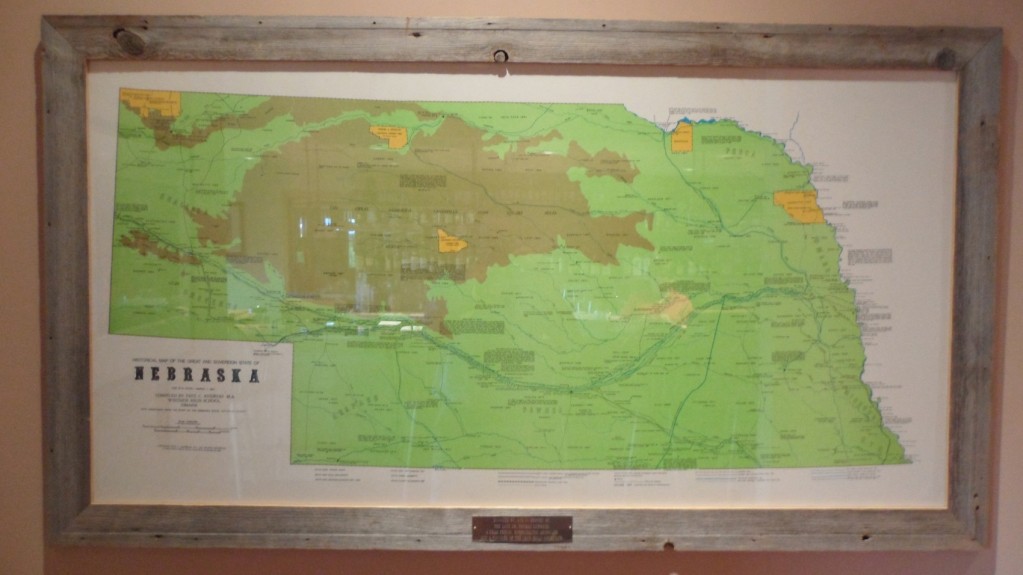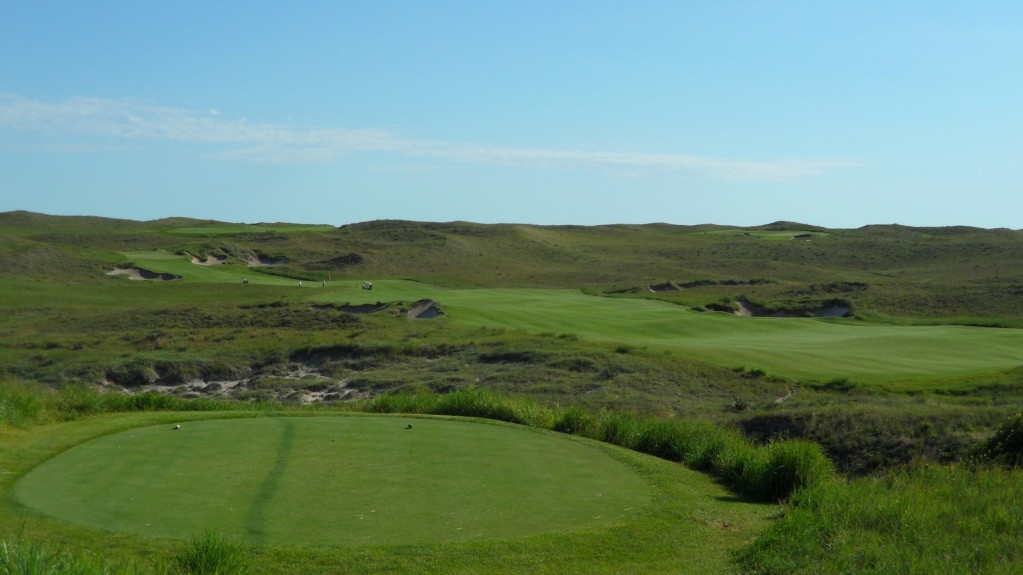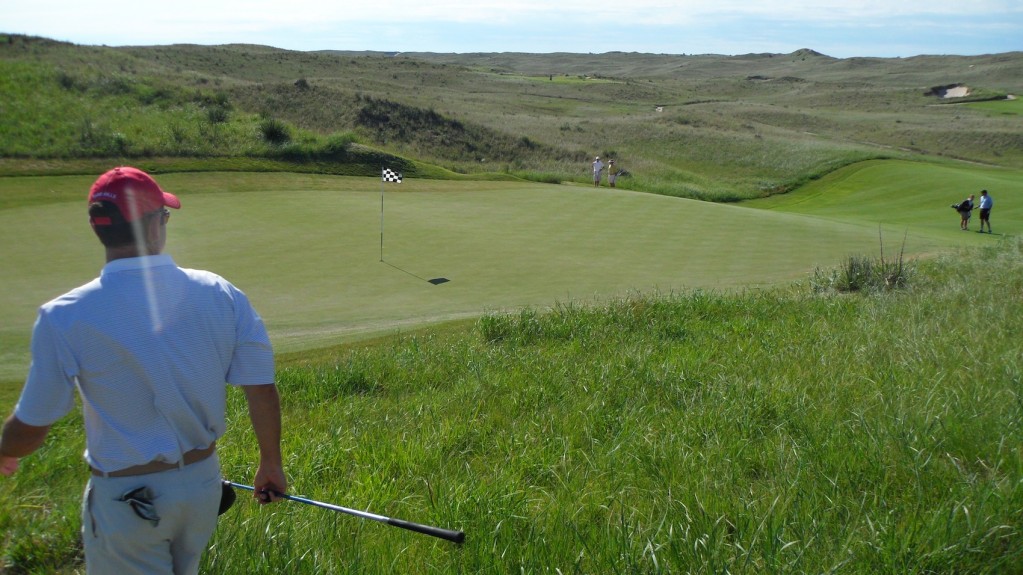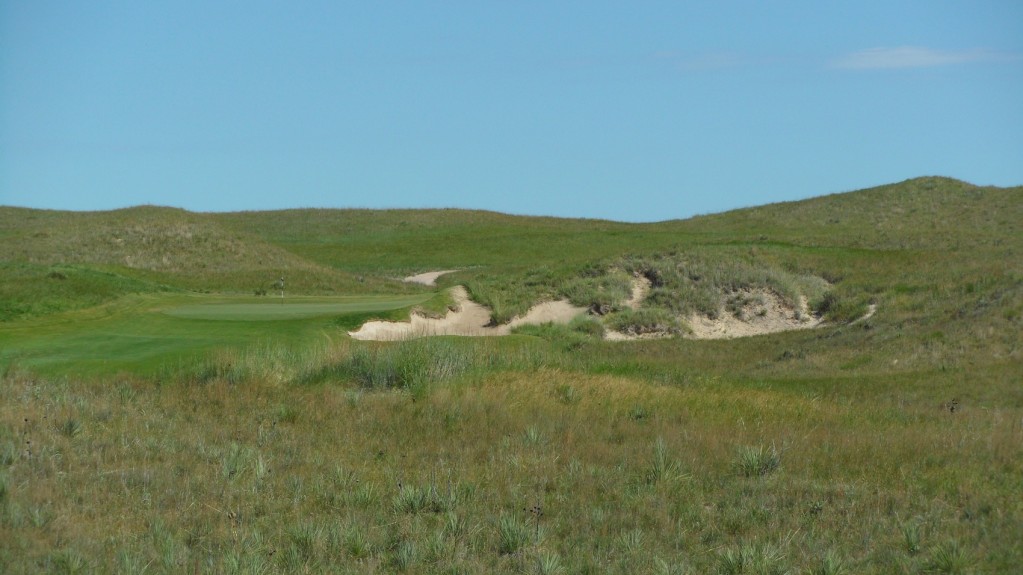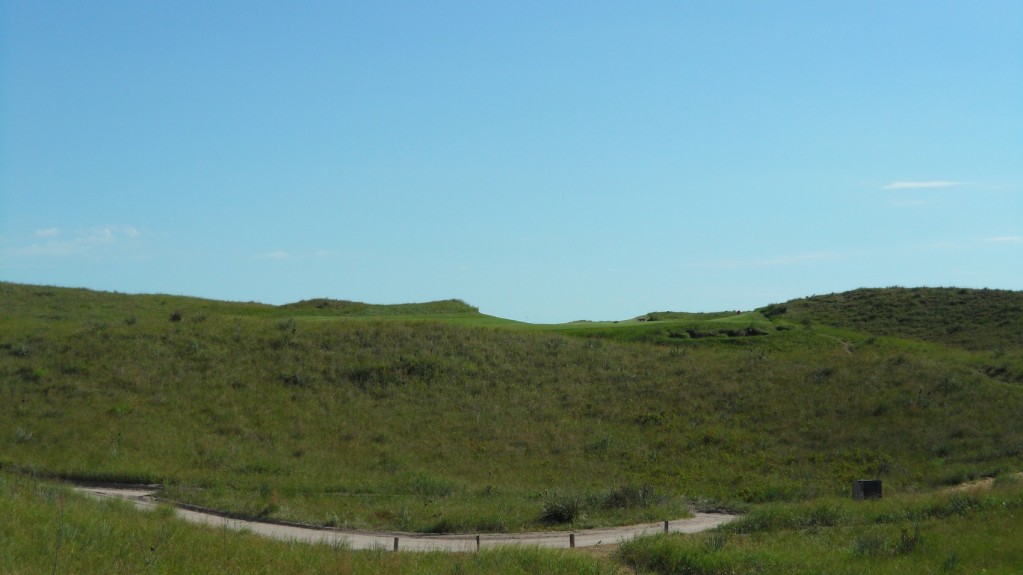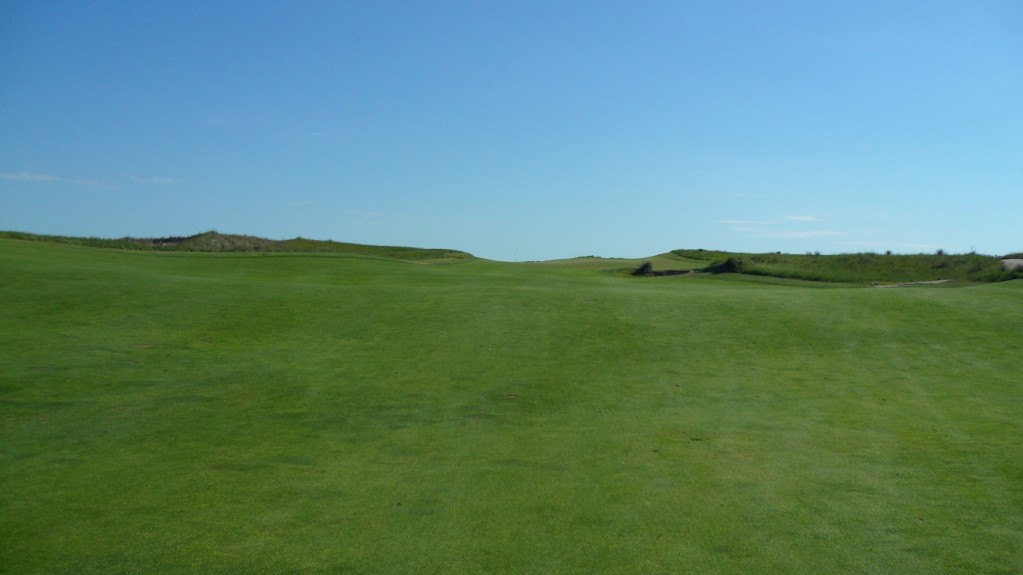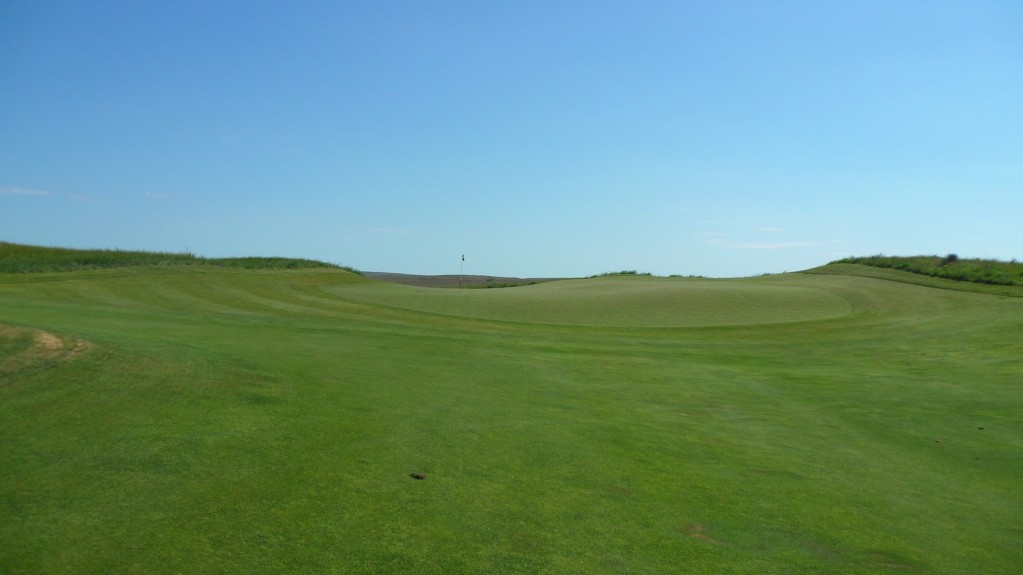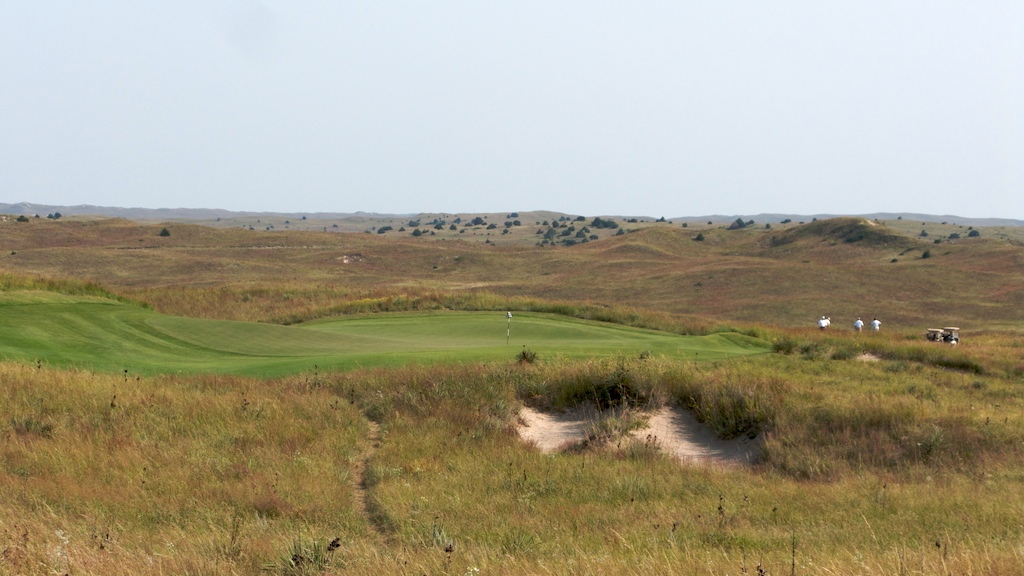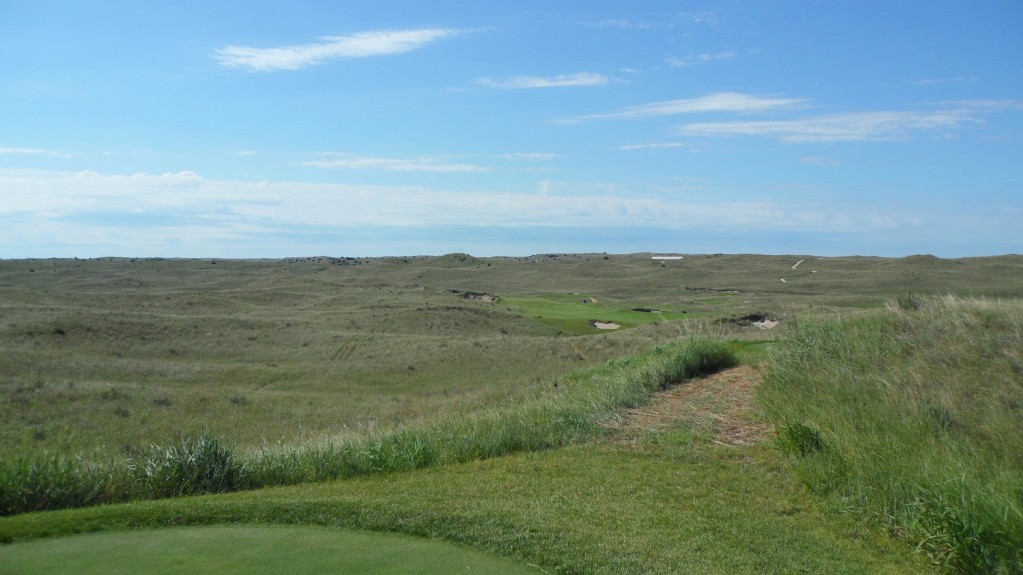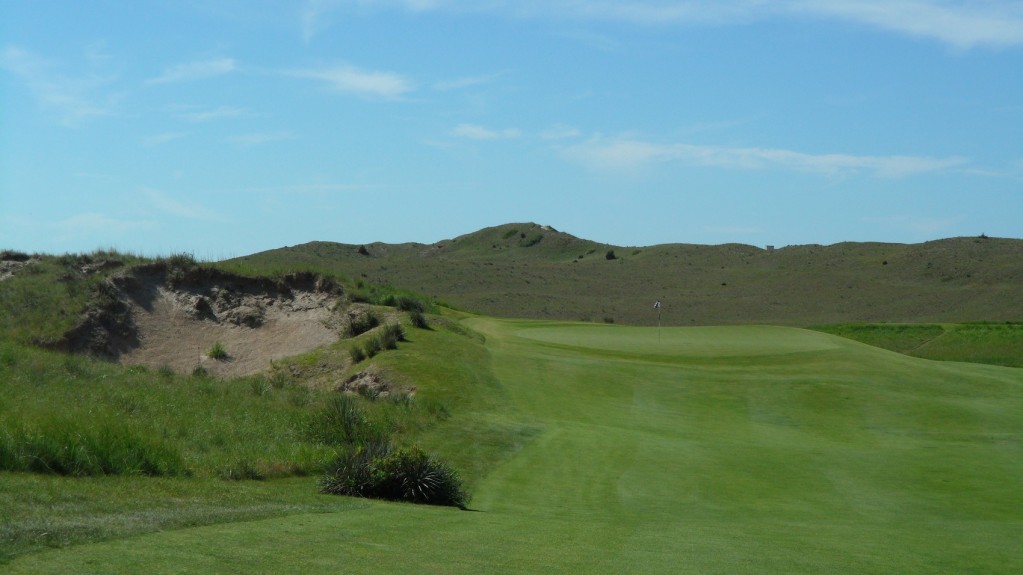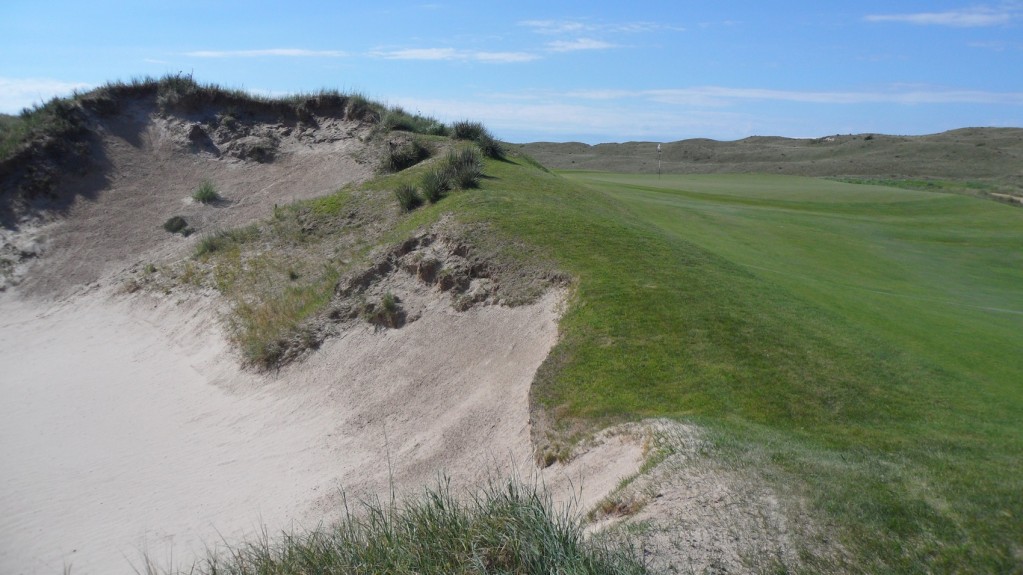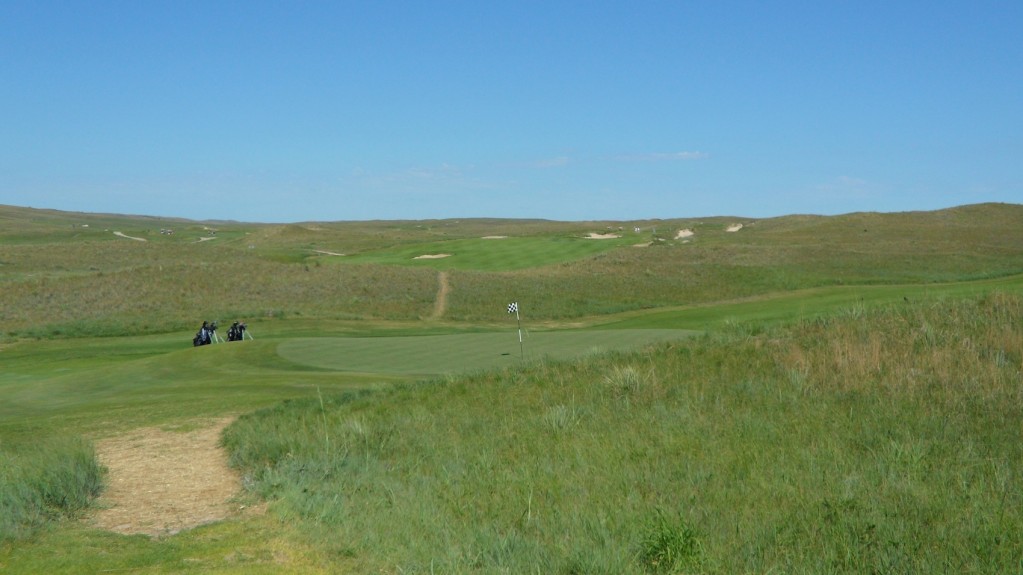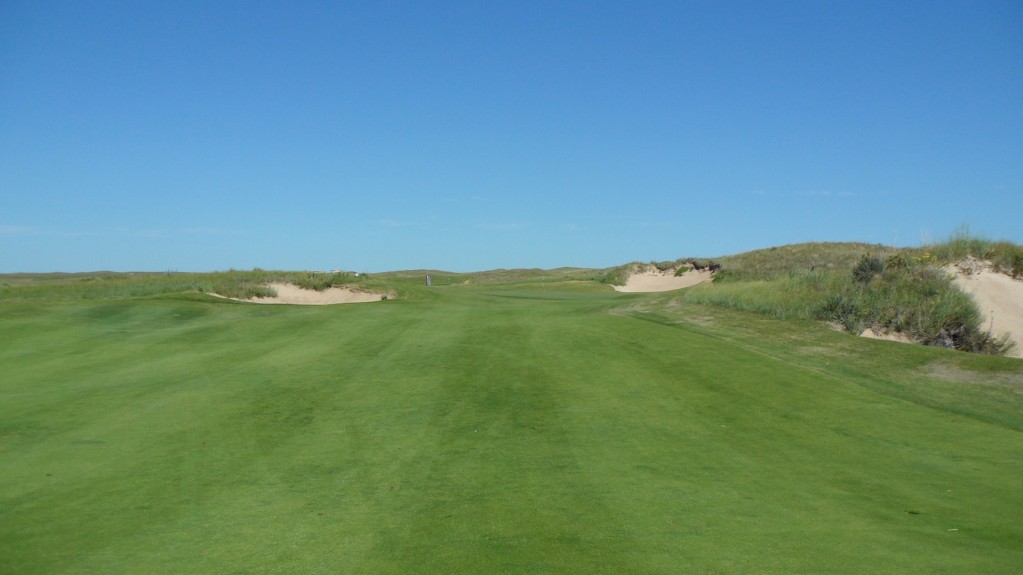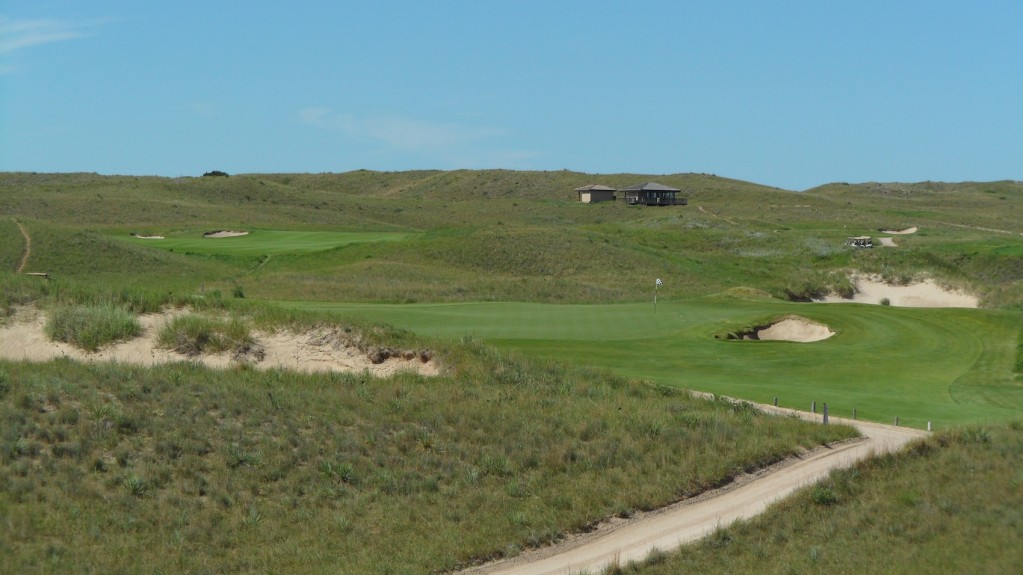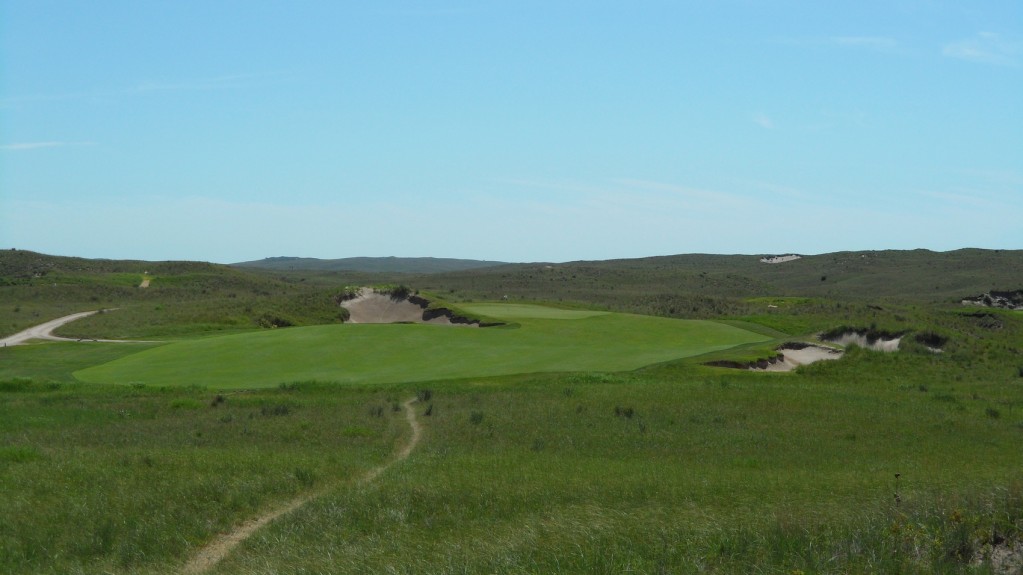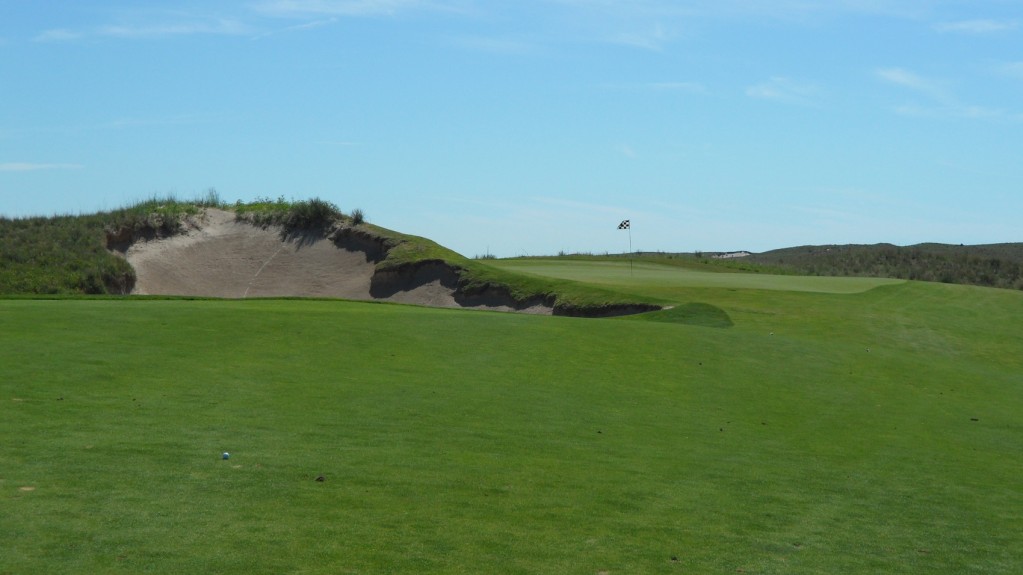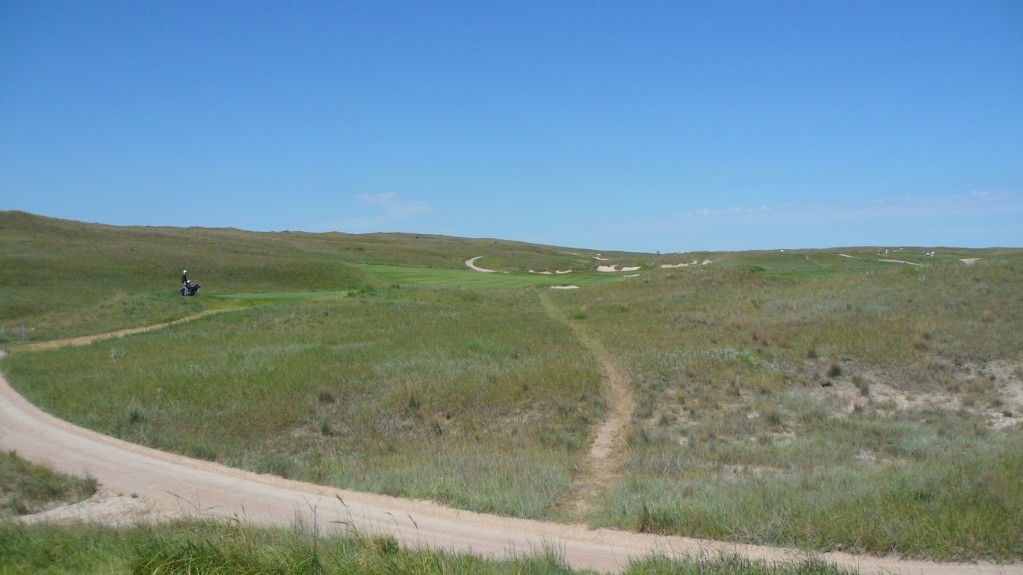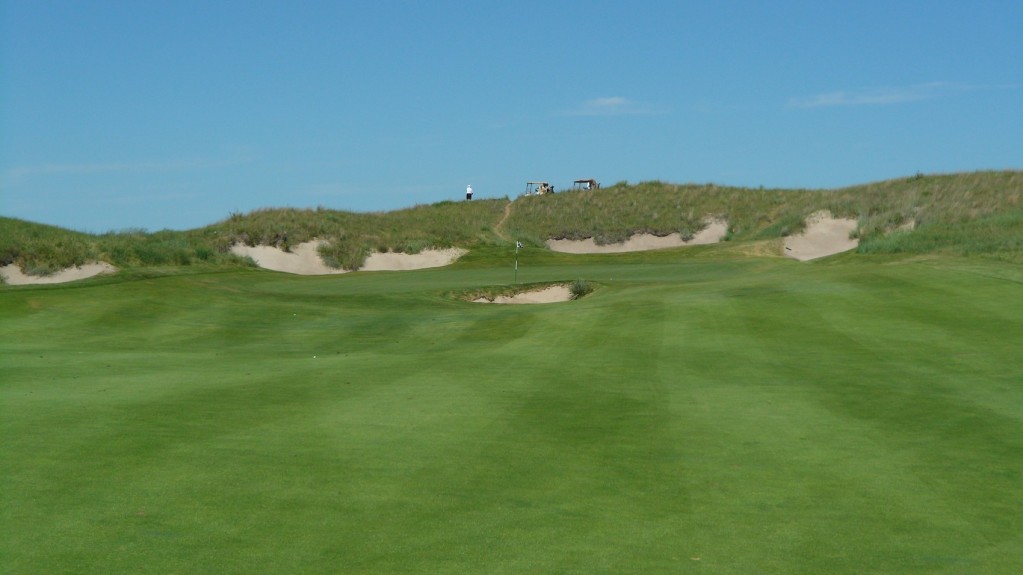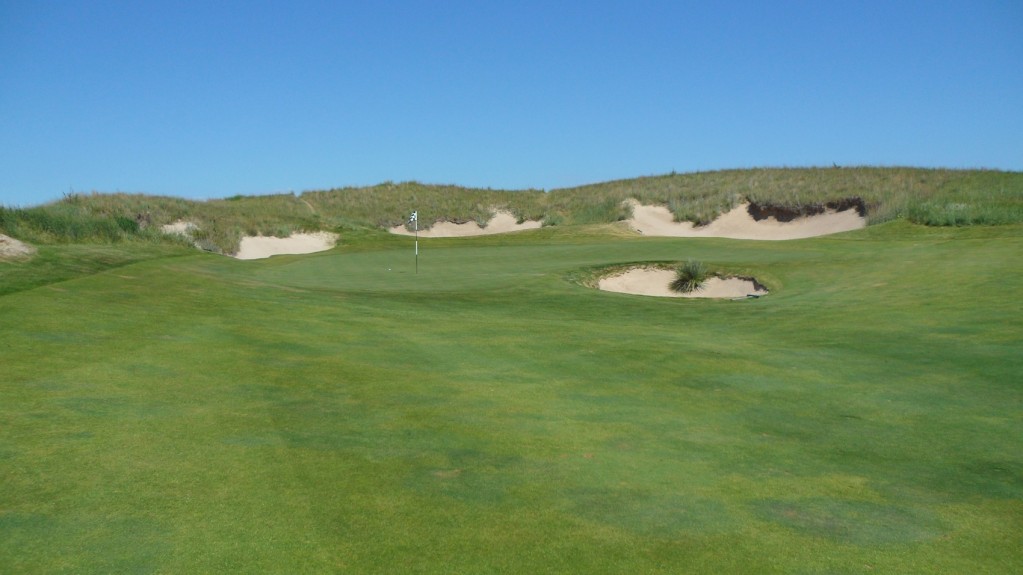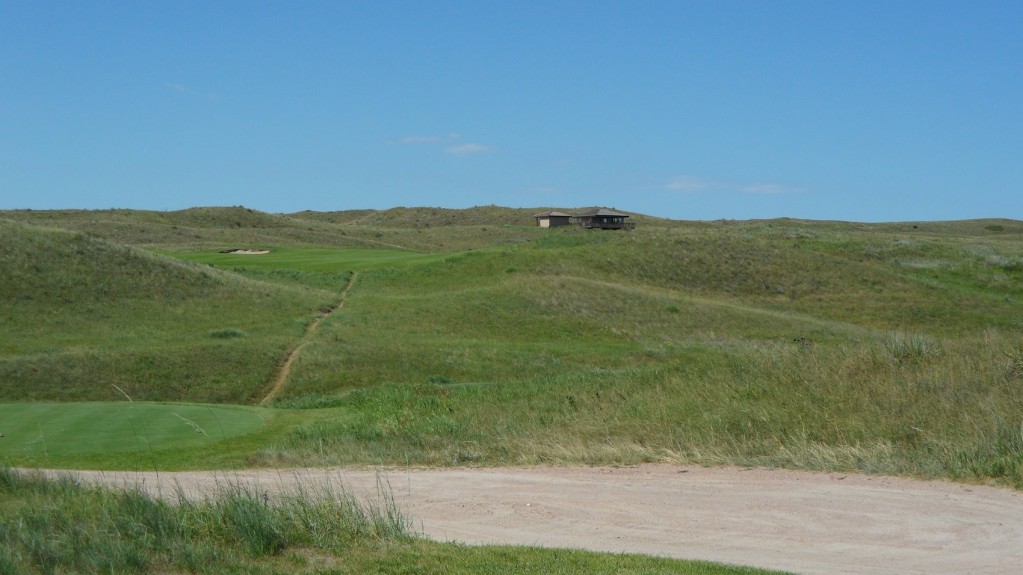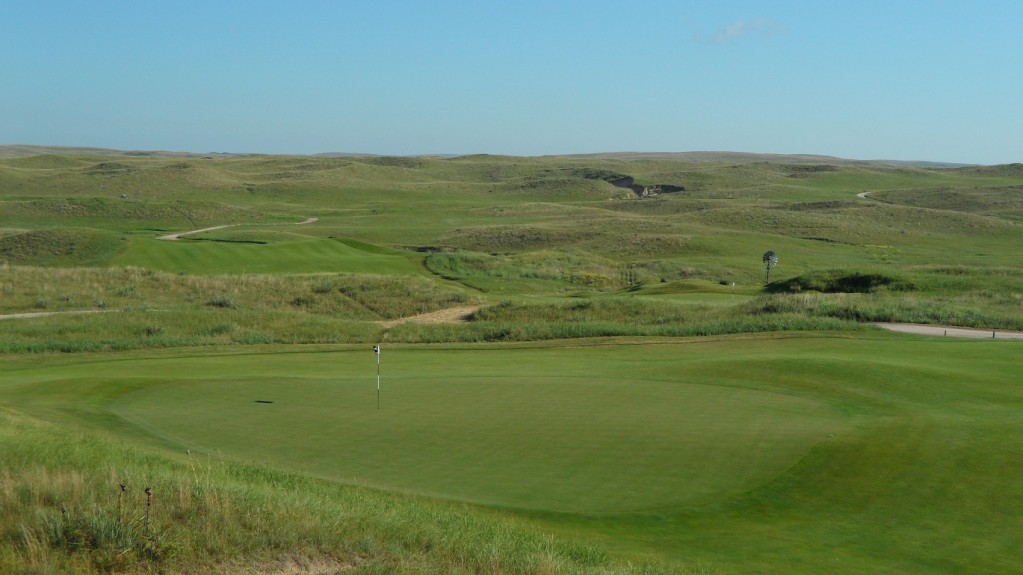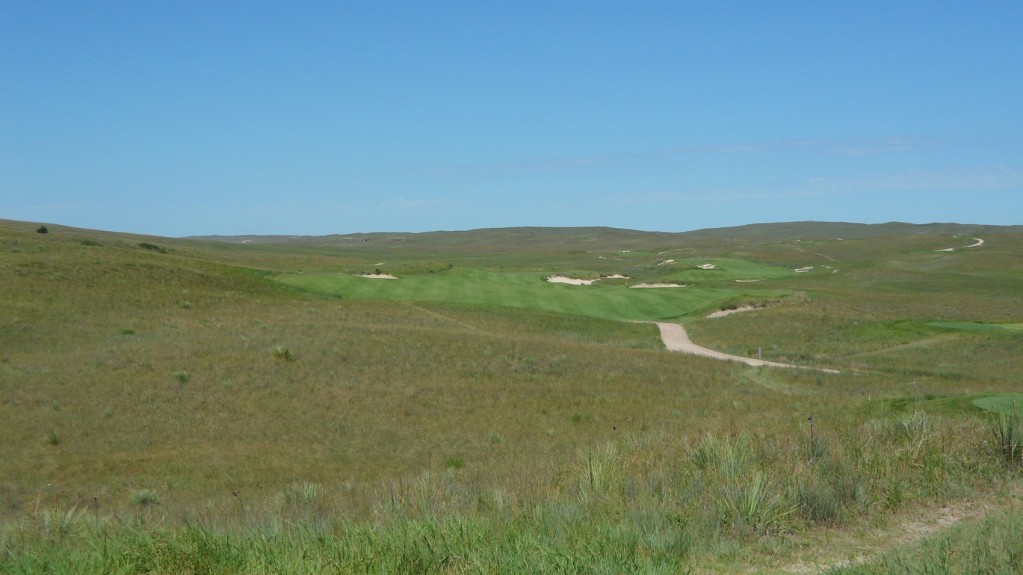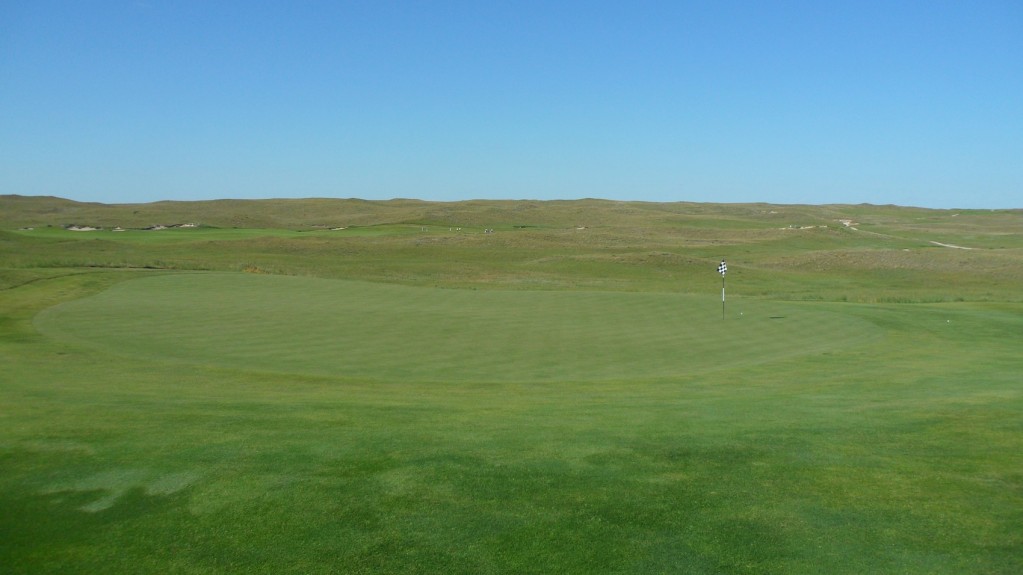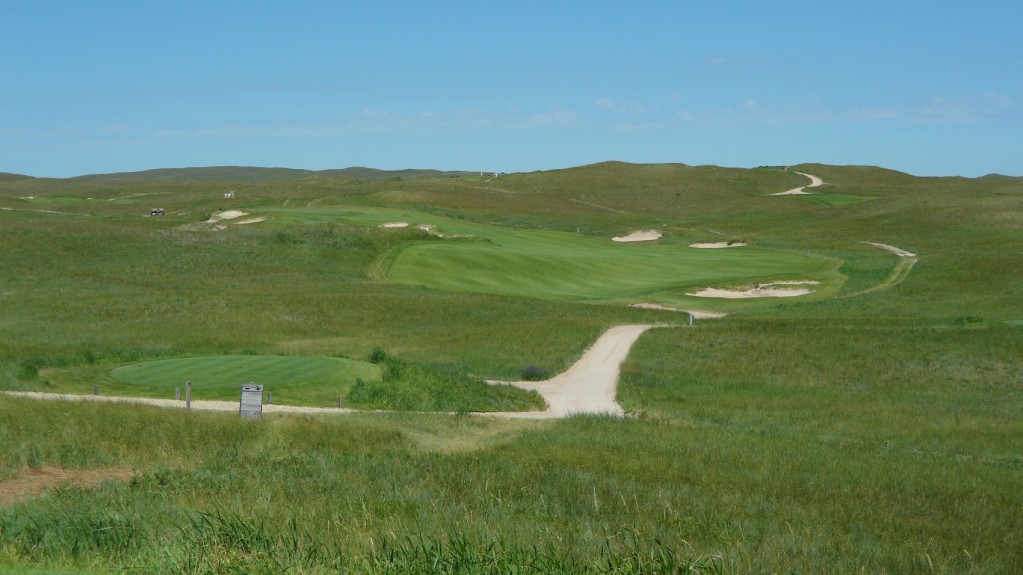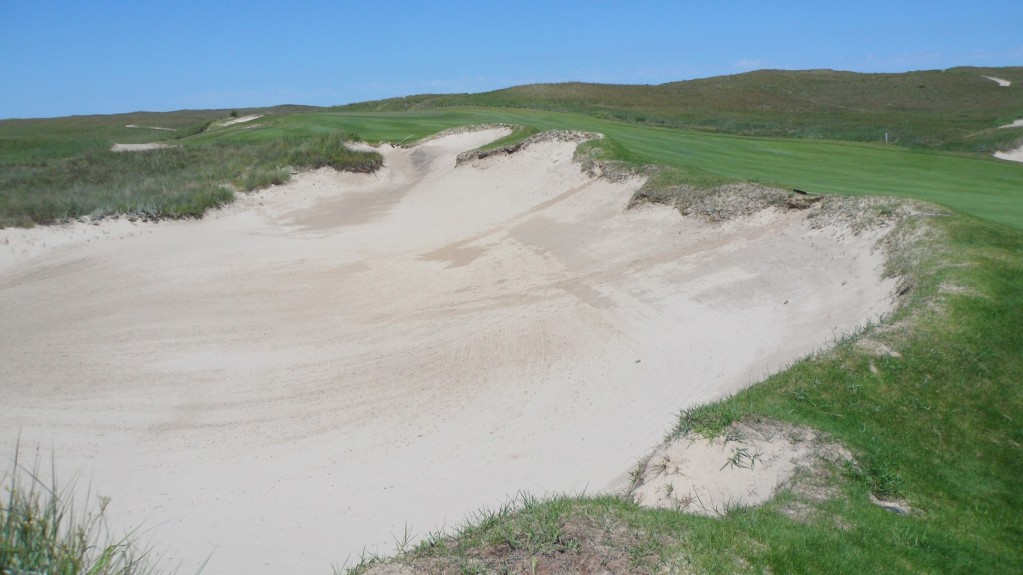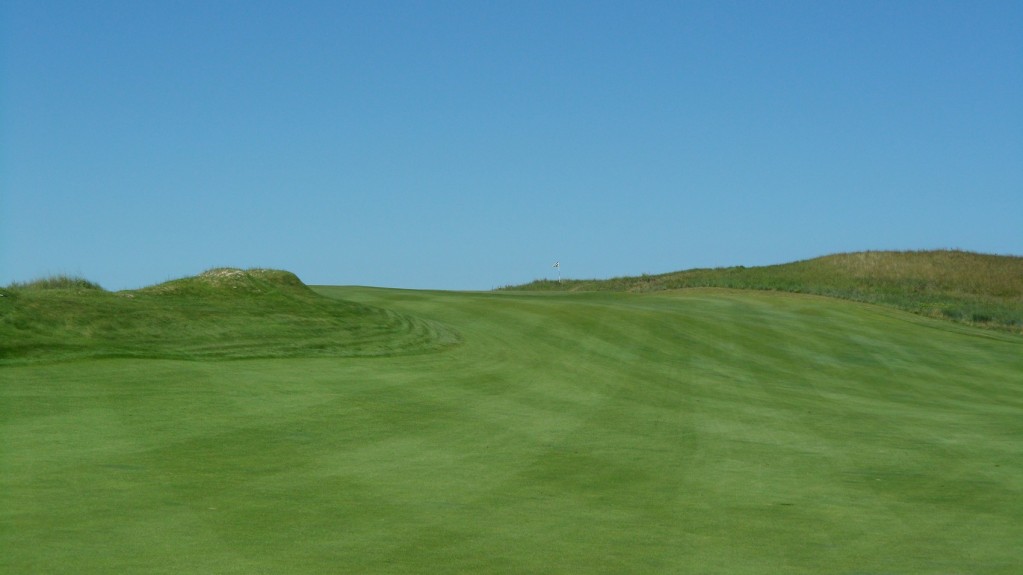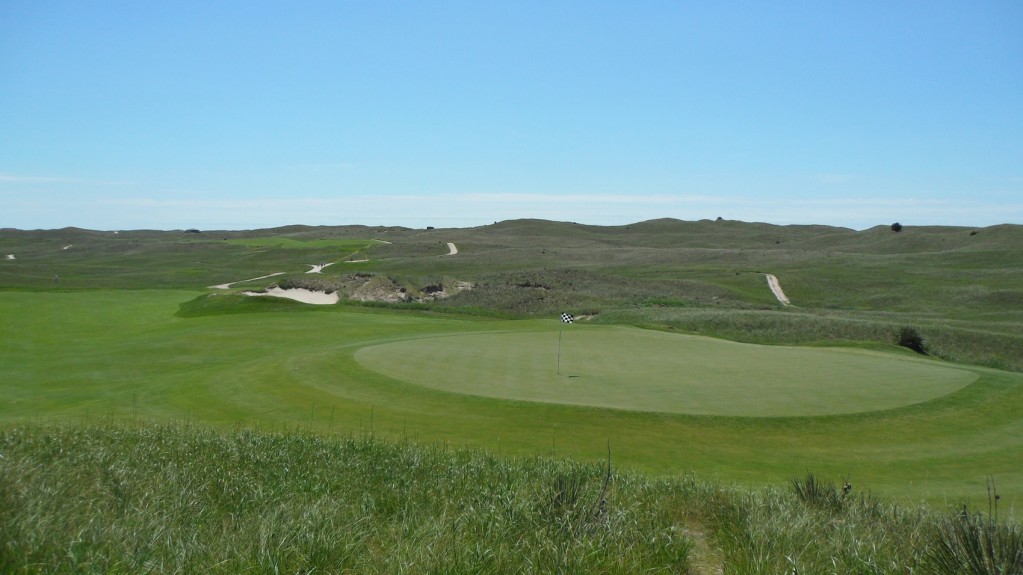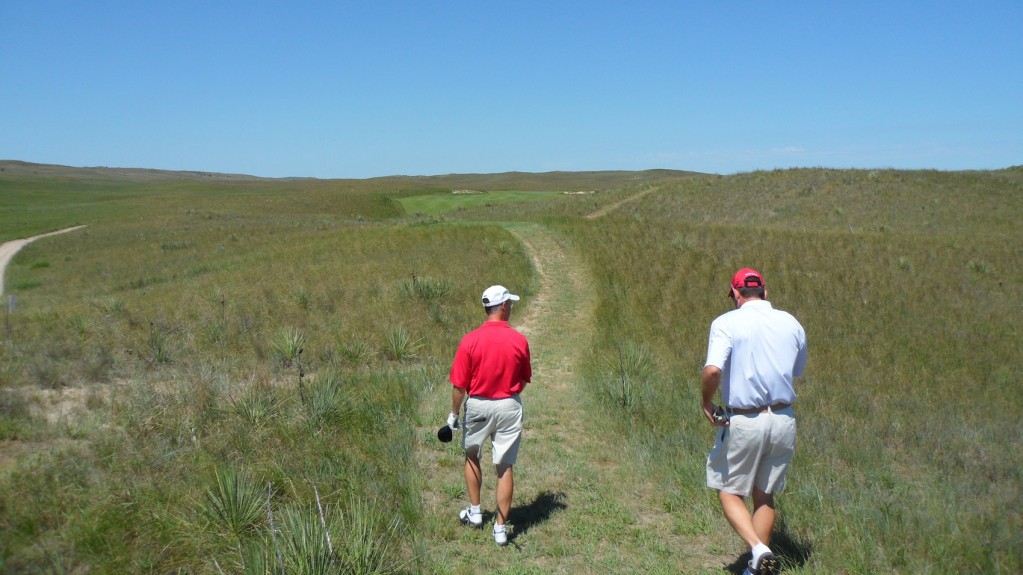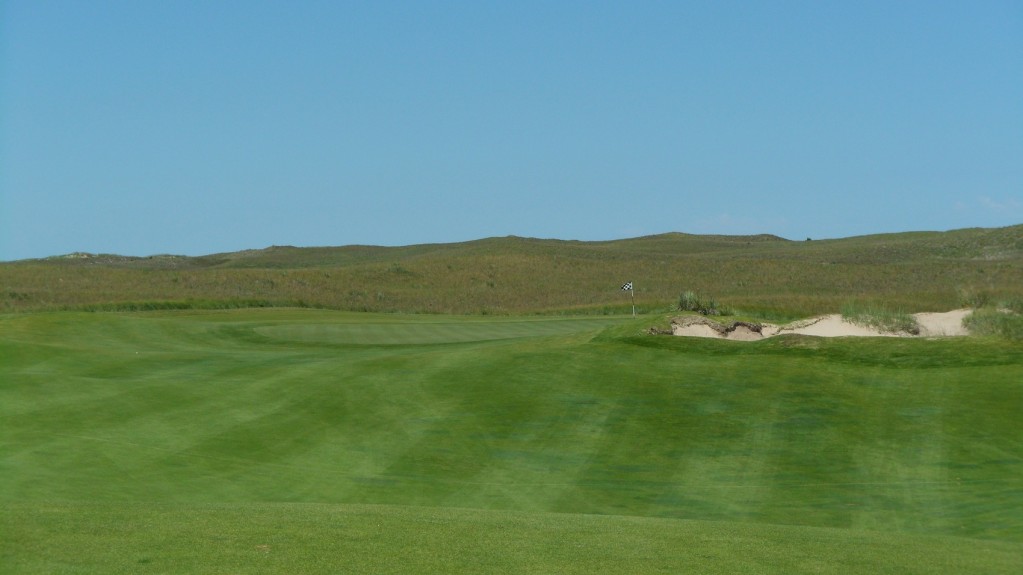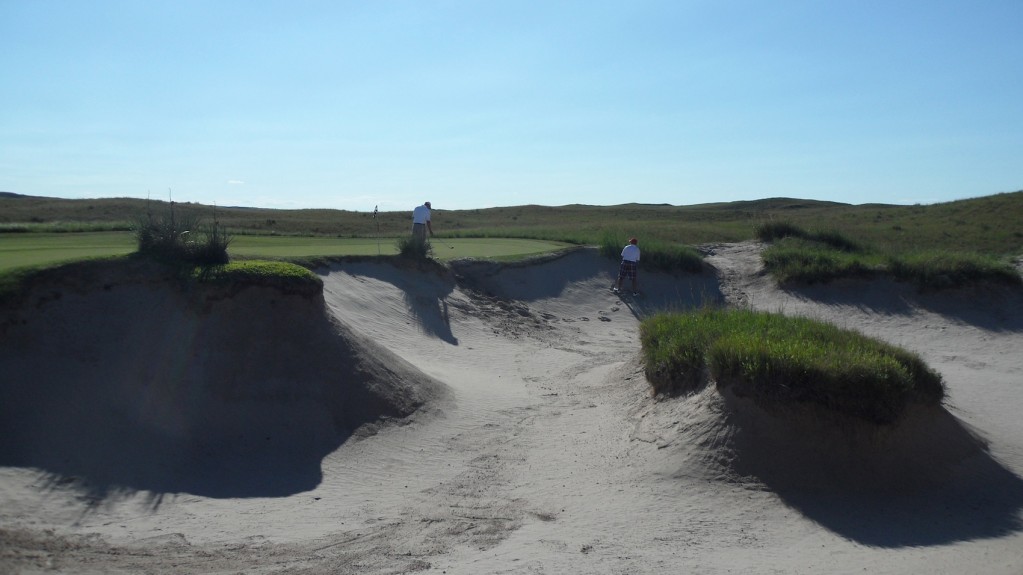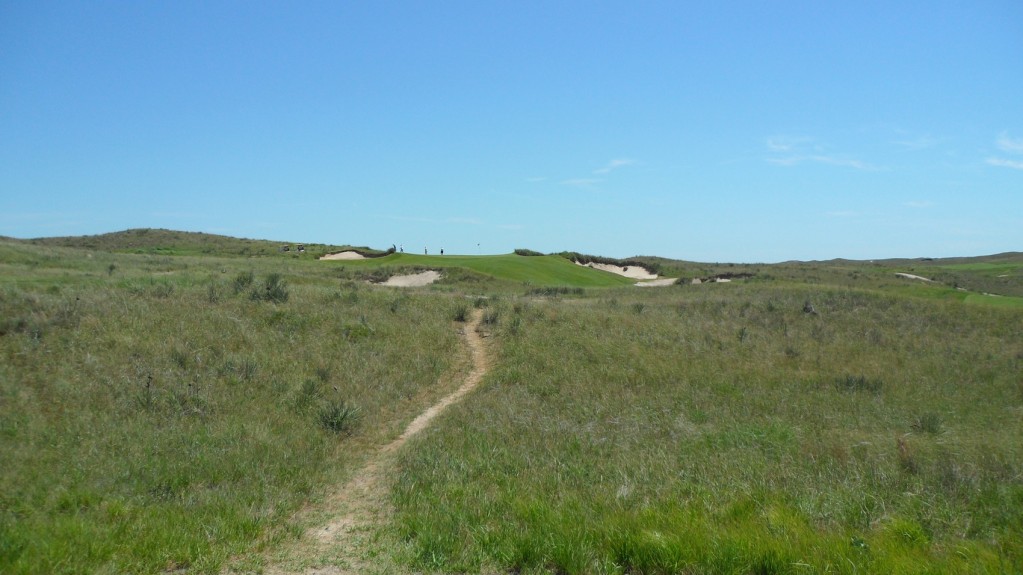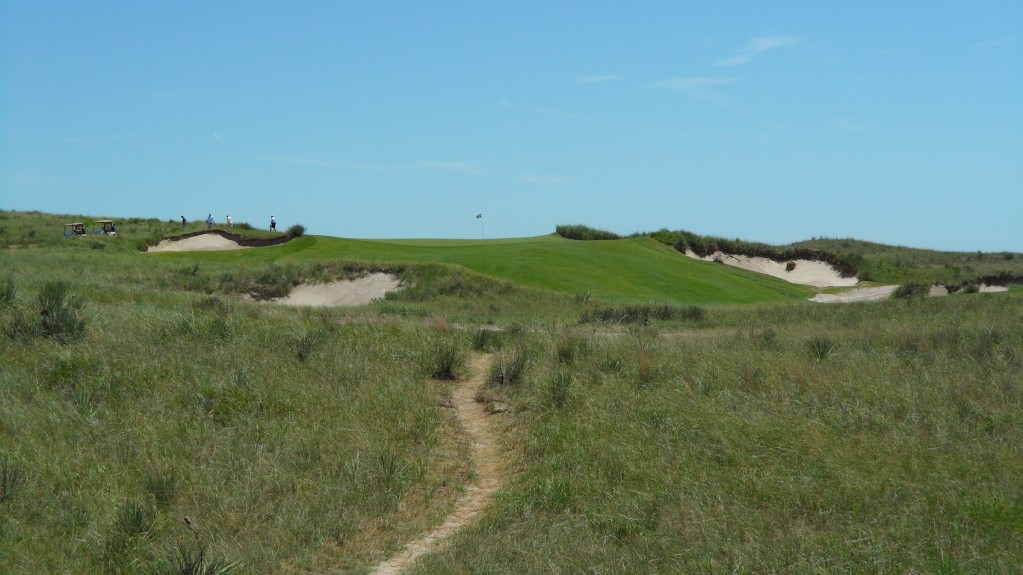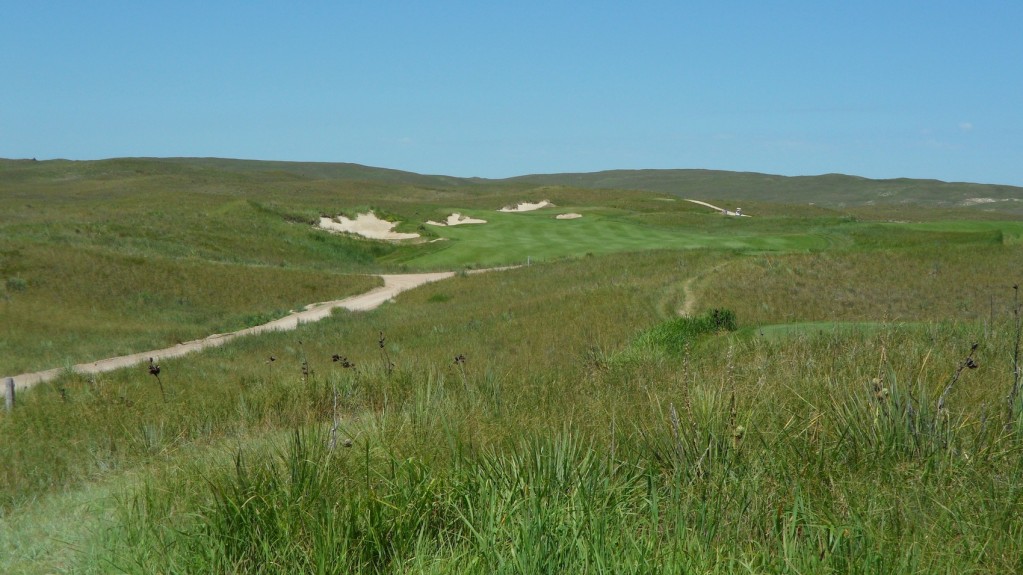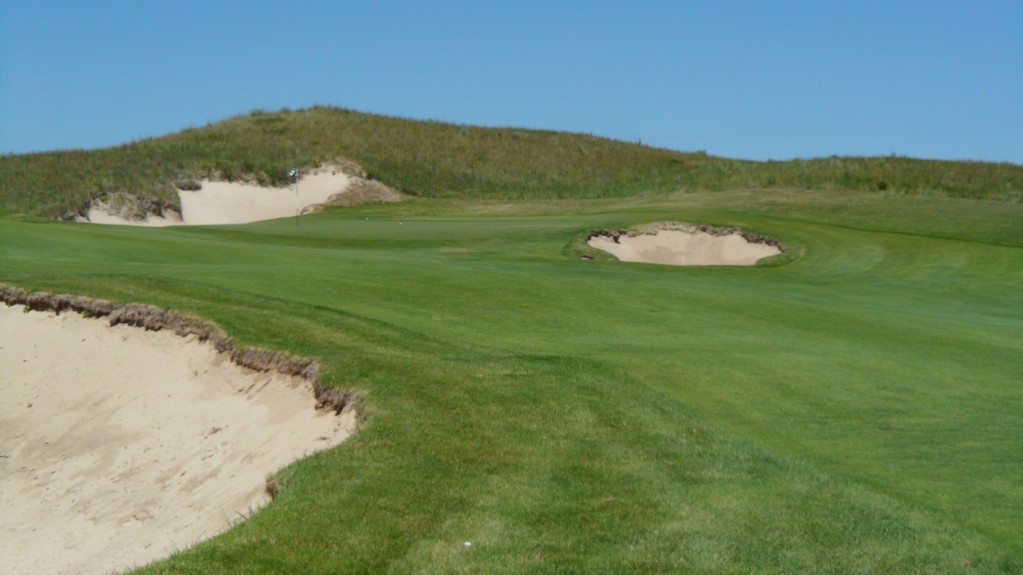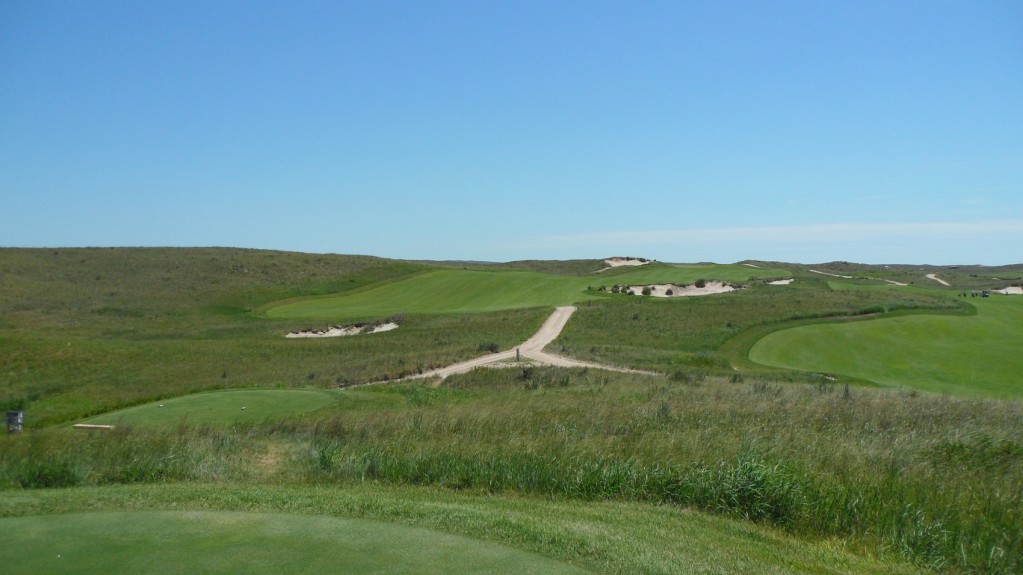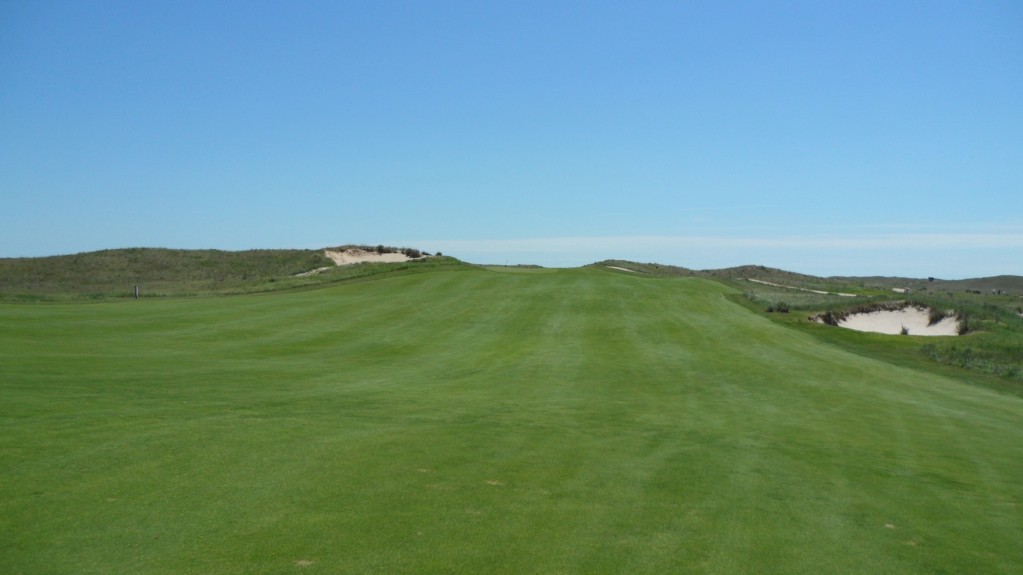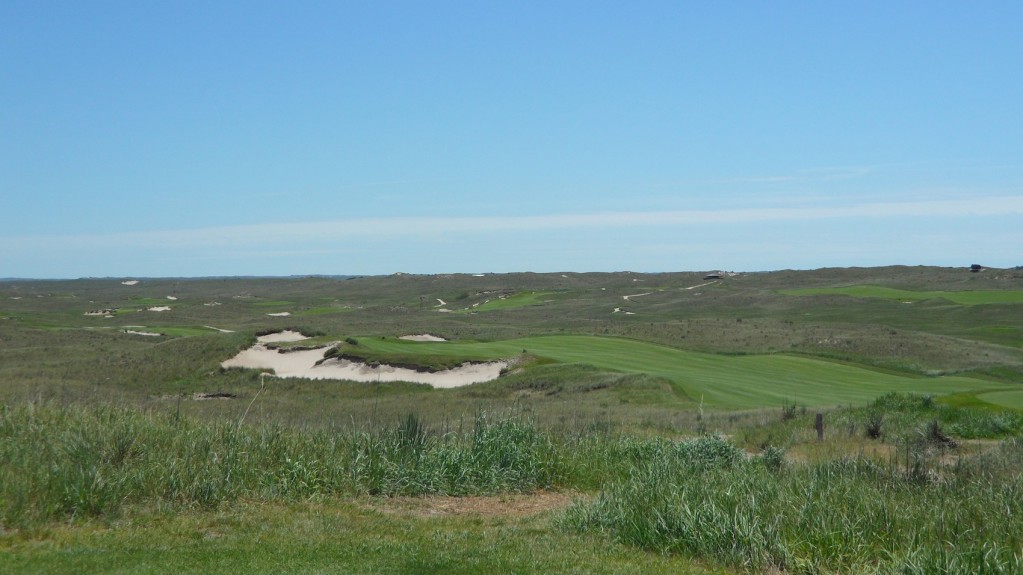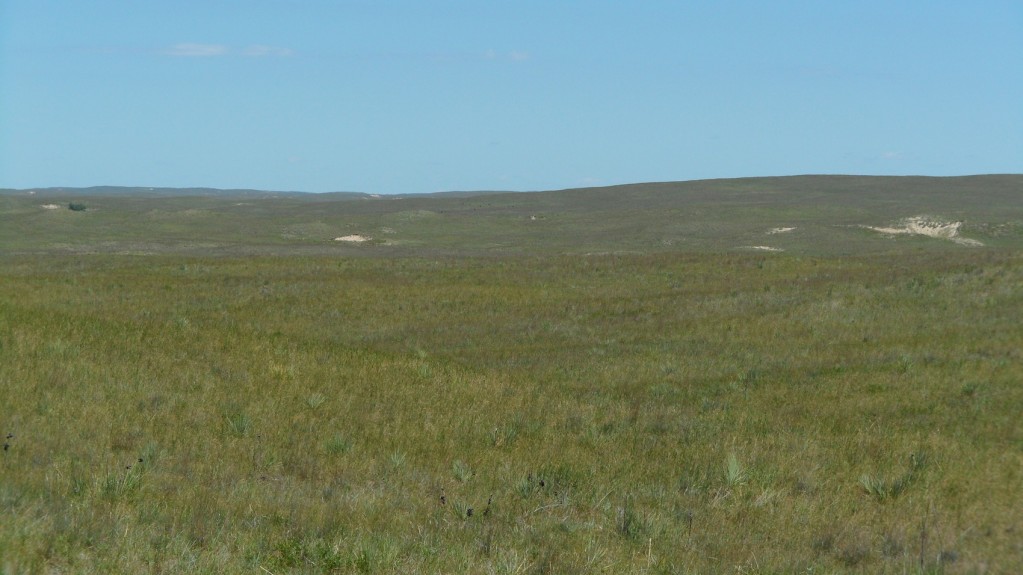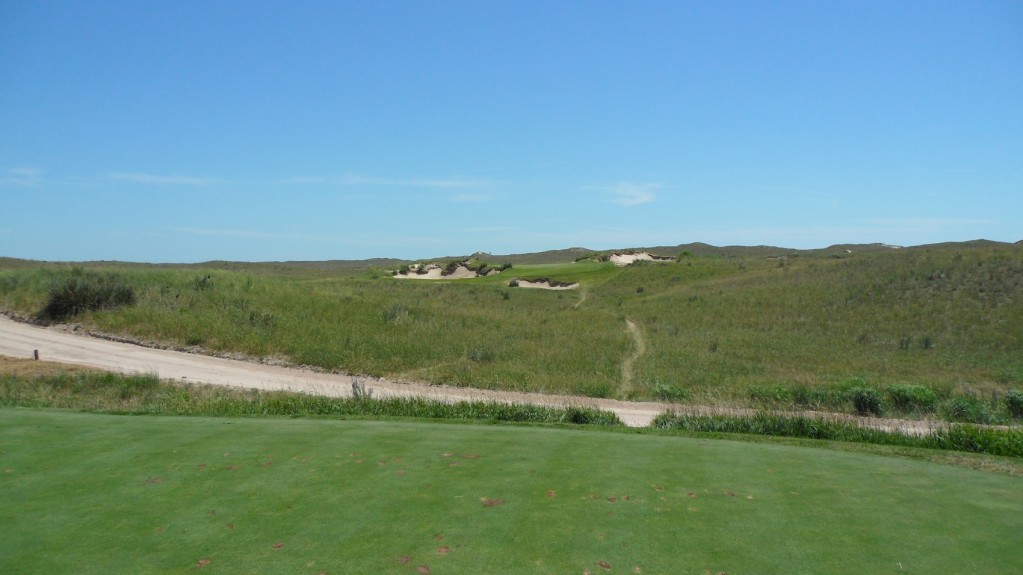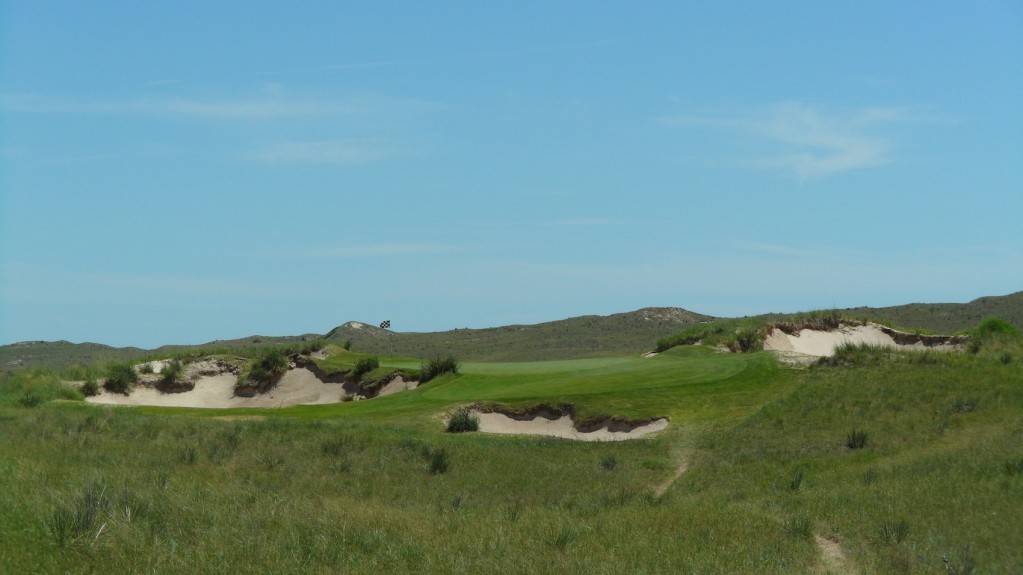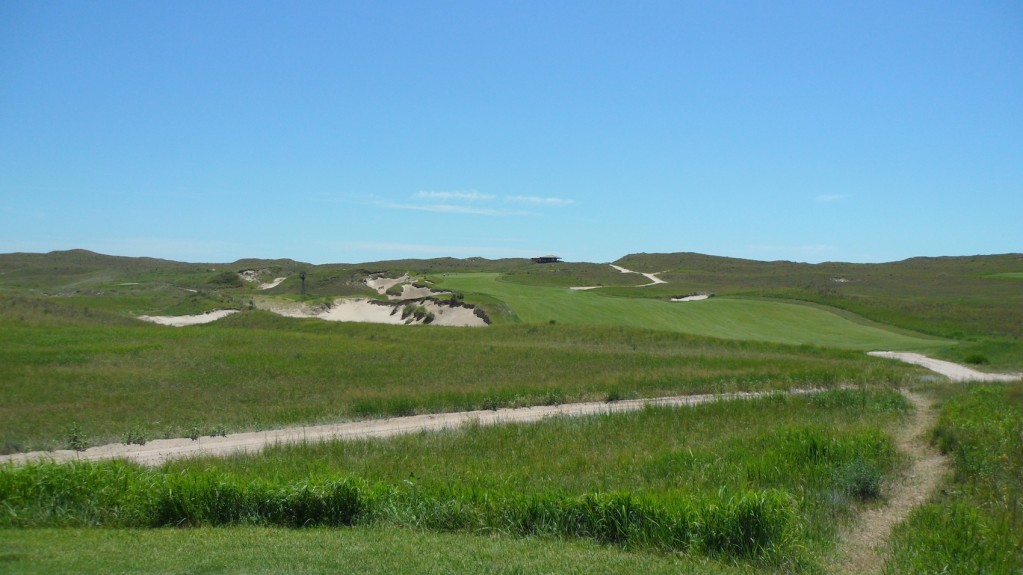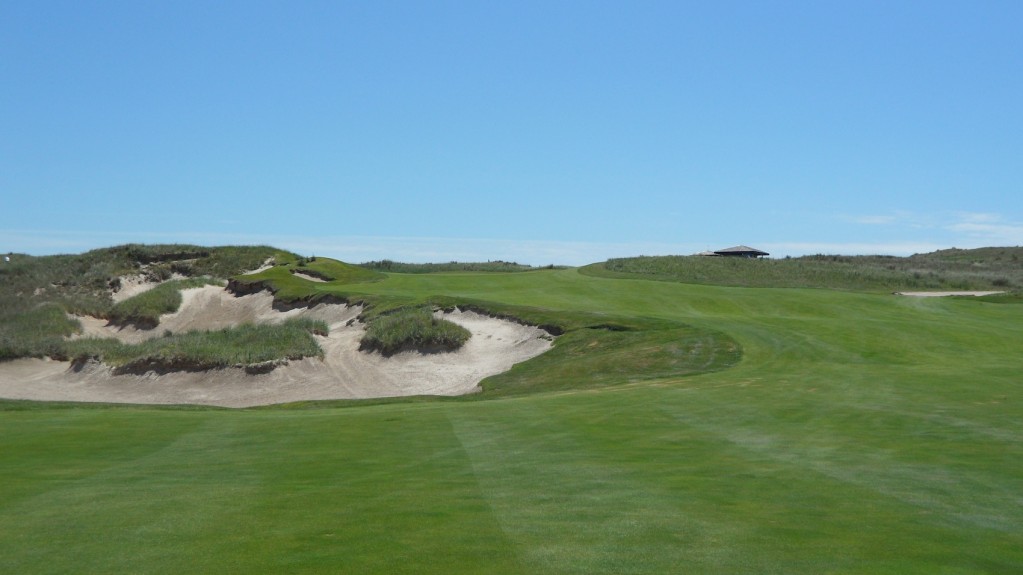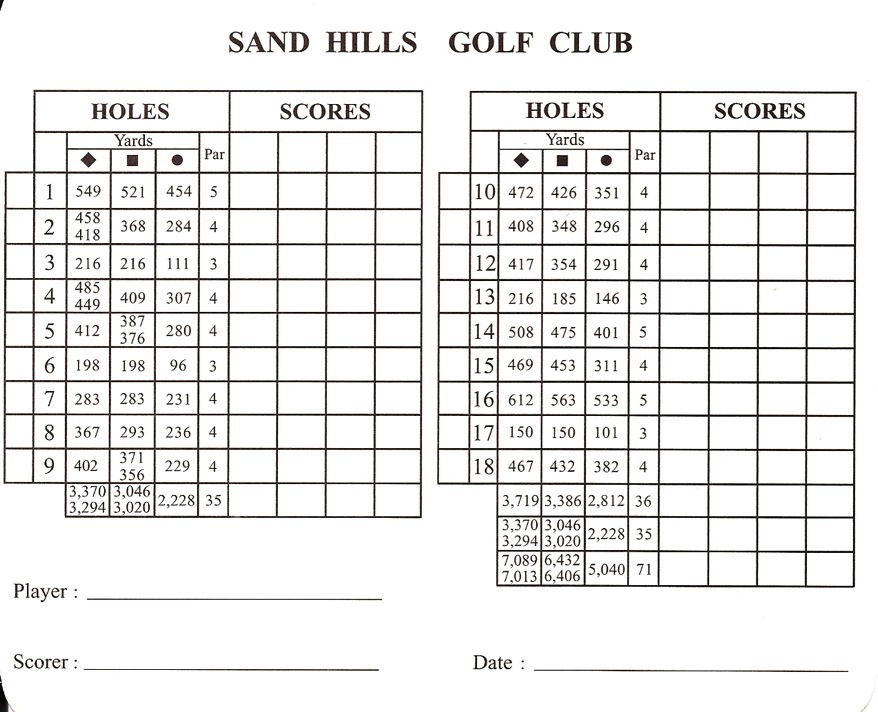 Sand Hills Golf Club
Sand Hills Golf Club
Location: Mullen, NE
Architect: Bill Coore & Ben Crenshaw
Year Constructed: 1994
Played: July 22-25, 2010
Sand Hills Golf Club is located in Mullen, Nebraska which according to the 2000 census has a population of 491. Unfortunately, I don’t know a single one of those 491 folks. Even if I did, I’m not sure it would help as nearly all of Sand Hills’ members do not live in Mullen. The club’s membership is mostly national members and therefore spread all over the country (probably the world). When you couple the spread out geography with the fact that the club has less than 200 members, meeting a member becomes quite the proverbial needle in the haystack .
Sand Hills Golf Club is the brainchild of one man, Dick Youngscap. Mr. Youngscap is a Lincoln based developer who was presented with an 8,000 acre parcel of land in 1990 that he thought might be ideal for a golf course. To put the enormity of this property into perspective, my home course is built on a piece of land that is roughly 150 acres. Theoretically, a person with 8,000 acres would have enough land to build more than 100 golf courses. The sand hills are an enormous region of Nebraska and undeveloped land is abundant. The photo below is a map that hangs in the clubhouse which has the sand hills region highlighted in brown. This shows exactly how large of an area we are talking about (it must be equal to ~1/5 of the state).
Mr. Youngscap put an option on the 8,000 acres so that Bill Coore and Ben Crenshaw could be brought out to determine if a golf course would be plausible. It was quickly determined that the land was ideal for golf and the purchase was made. After spending more time walking the land, Coore and Crenshaw managed to discover 136 natural golf holes on the property. When I say natural golf holes what I mean is that the hole was literally already there. Tee, fairway, bunkers and green. The only thing these holes would need to be playable is some very light finishing work and the planting of grass. Eventually, Coore and Crenshaw narrowed the 136 holes down to the best 18 holes that would also make sense from a routing standpoint. This was minimalism at its absolute finest.
In addition to the natural golf holes, it turns out that there are more natural assets to this piece of property. Upon close inspection it was discovered that the sand on this piece of land consists of grains that are perfectly round in shape. This tiny detail is important because that round shape keeps the sand from compacting too densely and allows for maximum water drainage. This is a huge benefit to the entire golf course and particularly to the greens. These perfectly round grains of sand are essentially the same thing as the U.S.G.A.’s greens mix (a special blend of sandy soil that has been identified as the ideal material for building greens that are suited to accept golf shots, grow grass conducive to putting and handle water drainage properly). The average cost to build a green to USGA specifications is $40,000. The average cost to build a green at Sand Hills was $300. Yes, $300. That is not a typo. There are no zeros missing. So, if you extrapolate those numbers across an 18 hole golf course you will quickly find that the Sand Hills Golf Club realized a savings of $714,600 in building their greens alone. Not too shabby! Between the natural golf holes, the readily available water and the ideal sandy soil it appears that Mr. Youngscap has discovered the perfect storm of golf course nirvana.
When it came to building the clubhouse and the sleeping cabins the same minimalist approach that worked for the golf course was put into play again. I’ve been to many a modern club with a 25,000+ square foot clubhouse that probably boasts a ticket price in the upper 7 and maybe even 8 figures. I am of the opinion that this type of expense is unnecessary and costly to the members. Sand Hills got it just right. The clubhouse is a decidedly understated affair that has all the necessities and is nicely appointed but does not smell of anything flashy, gauche or over the top.
The 1st hole pictured below from the tee is a par 5 playing 549 yards. Which way the wind is blowing determines the best line for the tee shot here. For the most part its pretty safe to aim just left of the bunker on the right side of the fairway or just to the right of the bunker on the left side of the fairway. Big hitters with a little wind behind them can definitely fly the bunker and put themselves in prime position to get home in two.
For the players who lay up the 3rd shot is straight up the hill. There is a false front on the green so be careful with a front hole location or else you may be hitting your fourth shot from off the green again. The photo below shows the slope of the green, the false front and the uphill climb for the third shot.
On the right side of the 1st green is the first of what will be many green side natural bunkers. These bunkers define the course and can also define your score. Some of them can be particularly difficult and require perfect shots to escape in a single stroke. The photo below is of the first green taken from another part of the course. The size of the bunker is evident from the photo, but its tough to get a feel for the depth. Its not a place you would want to visit.
The 2nd hole is a par 4 that plays 458 yards from the back tees. Its definitely one of the tougher holes on the course from the back tee box. The middle tees play a much more reasonable 368 yards. The photo below was taken from the back tee box.
The approach shot to the 2nd green is all uphill and requires a bit more club than the yardage would indicate. Especially if its into the wind.
The 2nd green is a quite the challenge. The upper right portion is essentially a shelf and any shots that don’t reach that shelf are coming back down the false front. When the hole is cut where it is in the photo below there is a better chance to hit it stiff as shots can catch the side slope of that shelf and feed down to the hole.
The 3rd hole is a nice par 3 that plays 216 yards from the back tees. I hit everything from a 19 degree hybrid to a 6 iron on this hole. It seemed to be playing either dead into or dead with the wind. The green has a huge mound on the left side which makes back hole locations tough to get close to. A knock down shot that runs on the ground after landing is a pretty good option to play for that hole location.
The photo below was taken from the back tee box on the 4th hole which played 458 yards. The carry to get the ball down to the fairway was not for the faint of heart.
Depending on the wind the approach shot on the 4th hole can be of varying distance. I managed to birdie this hole both times we played it the first day . . . both times nearly holing out from the fairway for eagle. The first time I spun the ball backwards and it rolled by the hole missing by less than an inch leaving me a four footer for birdie. The second time I hit to the left side of the green and the ball rolled down to the hole and lipped out leaving a 18” putt for birdie. This hole is a cinch right? When the wind was against us I had to layup my second shot and hope to get up and down for par. Completely different hole. The photo below is of the green and the enormous bunker that flanks it on the left.
During my first round here I asked one of the guys who had been to Sand Hills many times if anyone ever hit into that bunker because it didn’t really seem to be in play all that much. He assured me that before the weekend was over I’d see at least one person in the bunker. Here is another view to give an idea of exactly how deep this bunker is.
Interestingly, the tee shot on the 5th hole plays directly over the 4th green. This hole is a 412 yard par 4 and the bunker out there in the middle of the fairway is definitely in play. I found the best success keeping my drives to the right of it. Sometimes too far to the right, but the hole is still manageable from far right.
This might be a good time to mention the caddies since I’m talking about hitting my ball way right. Surely you’ve noticed by now that the course contains an extraordinary amount of native grass. The grass is very playable in most parts, if you can find your ball. That’s where the caddies earn their keep. These guys and girls were absolutely amazing and they could find everything. They found balls of mine that I wished they didn’t find!! All of the caddies that I saw were young high school or college aged kids and they were absolutely there to work, every single one of them. Many of them drove for over an hour for the opportunity to caddie and they attacked their job with gusto. In the mornings we had them carrying our bags and in the afternoons they fore-caddied for us.
Now, don’t think for a minute that fore-caddieing is any kind of slack afternoon loop. Once all four tee shots had been hit, if any of them had flown near the long native grass (in my group there was usually at least one) these kids were off like a rocket running, yes running, to where they expected the ball to be. Usually, by time we drove down the fairway in our carts they were standing there with the wayward ball marked and ready for the next round of shots. They were remarkable young men and women. When I think of a Sand Hills caddie the image the pops into my mind is a young Nebraskan decked out in khaki shorts and a white shirt running down the path on the way to find a ball. Every time I looked these kids were running. They were truly impressive. Anyway, back to the course.
Here is a view of the approach shot for the the 5th hole.
The 6th hole is a 198 yard par 3 that seemed like we played into the wind every time. The hole location in the photo below is definitely one of the more difficult ones as it brings the bunker into play. The next day the hole was cut down in the lower left which was much more friendly and yielded three birdies and a par in my group for the morning round.
he 7th hole is one of my favorites as I love the short par 4s. This one plays just 283 yards from the tips and allows the option of trying to drive the green for those willing to take the risk. I elected to hit a 5 iron off the tee each day rather than bombing it up the right side to try to get it on or close to the green. If you’re going to drive the green a low draw is probably the ideal shot. If you overcook it the ball is going to end up in the deep bunker on the left and its not an easy out from there. I only saw this green get driven once in the 5 times I played this hole.
After hitting 5 iron off the tee the shot into the green is a simple little 70-80 yard wedge. Too far to the left and that deep bunker comes into play. Although I never hit into it with my drive, I did have to hit over it with my second shot a couple of times. I also never birdied the hole. I had a tough time making any putts all weekend long.
The 8th hole is another short par 4 and runs parallel to the 7th hole. From the back tees this one plays 367 yards. However, from the middle tees is plays 293 yards which makes it a very drivable hole especially if it is playing downwind. I saw at least 3 guys drive this green and a lot of balls right up close to the green. I hit driver every time I played the hole, but never quite got it all the way there. The photo below was taken from the back tee which takes the drivability out of the hole except for exceptionally long hitters playing the hole downwind.
The green at the 8th hole is one of the more famous ones at Sand Hills. It slants from right to left and from back to front. The bunker in the middle is every bit as diabolical as it looks. The photo below was taken from about 100 yards out where I hit my approach from when we played the back tees. The hole location in the photo below is a little tricky and brings the front bunker into play in a big way.
Here is another angle of the 8th green. This hole location is sneaky tricky too. We had a player in our group who hit a perfect shot and the backspin on the ball gave it just enough momentum that it rolled right off the green and into the bunker. Hitting an approach shot close to the hole on this green is a pretty risky and tough shot. I think the best play here is to the left of the bunker leaving an uphill putt, or bump and running it along the ground to the right of the bunker and letting it feed down. Either way, a great hole.
The 9th hole is a 402 yard par 4 and the drive is similar to the drive at the 2nd hole where most of the hole is out of site. For some reason this drive got into my head and I just couldn’t hit a good shot here all weekend. If you take your drive straight up the walking path and hit it well you will be in position A and have a very manageable approach to the green. Apparently I never got that memo and butchered this hole nearly every time I played it.
Below is a photo of the 9th green. This one is very receptive to bump and run shots although there is mounding that needs to be avoided as shots are running up to the green.
After finishing up the 9th hole players walk up to Ben’s Porch which is the modest little halfway hut and porch that overlooks the course. Here you will put in your order with the resident cowboy grill master for what you would like to have for lunch. If you want a burger they’ve got the best there are. If necessary they can rustle up a little yardbird and grill that for you too. Whatever you decide to order, it will be ready for you when you walk off the 18th green.
So after the quick stop at Ben’s Porch its off to the 10th tee. This hole is a monster that plays 472 yards from the back tees and is a par 4. You just want to hit it down the middle and hope that you get out there far enough to have a reasonable approach shot to the green.
The 10th green sits slightly below the level of the fairway, so the good news is that shots that come up short at least have a chance of bounding downhill and finding their way onto the green. The 10th green is in the photo below.
The 11th hole plays as a 408 yard par 4 and is a fantastic hole. The photo below was taken from the back tee box. If there is one thing you do not want to do here it is go left to that sandy area on the left edge of the fairway. Do NOT go left! There is plenty of room out to the right so just hit it out there and play it safe.
If you do have the misfortune of going left that sandy area in the photo above is an enormous bunker that will make the approach shot infinitely more difficult. Below is a photo that gives an idea what that approach shot would look like.
If you play to the right the approach shot is much more friendly. As you can see in the photo below there is no real trouble to be negotiated from the right side of the fairway.
And here’s a photo from behind the 11th green looking back down the hole.
The 12th hole is a fairly straight forward 417 yard par 4. The photo below was taken from the back tee.
From the middle tees this hole is a much different animal playing only 354 yards which leaves a relatively short shot into the green. There is a nasty bunker next to the green that may have to be negotiated depending on the location of a players drive and where the hole is cut on that particular day. The photo below was taken from where my approach shot was played after a middle tee drive.
Missing the green can mean squaring off with this bunker. Note the island in the middle which I’m sure has caused problems one or two times. Brad was pretty lucky in the photo below and his lie was not too bad.
The 13th hole is a par 3 and a serious one at that. From the back tees this hole plays 216 yards all uphill and surrounded by very big bunkers. From this distance it is very difficult to hit a tee shot that will hold the green. Nick Faldo managed to post an ace here. I don’t suspect there are many of those here. The photo below was taken from the back tee.
Here is a little more zoomed in photo. This hole was much more manageable from the middle tees which played 185 yards. I never hit this green once, but managed to get my ball up and down for a couple of pars here over the weekend. Only once did I find the huge bunker on the right. I did not get that one up and down. It took me three strokes to get out. Not good.
The 14th hole is a wonderful par 5 that plays 508 from the back tees and 475 from the middle tees. All you have to do here is pop it out there down the middle and even from the back tees you’ll likely have a chance to get home in two.
Here is a little closer view of the green. There is all kinds of bunker trouble around that green so shots into the green should be well calculated.
The 15th hole is another long par 4 that plays 469 from the back tees. The middle tees don’t get much of a break and are only 16 yards shorter at 453 yards. Hitting it up the middle and avoiding the bunker on the right is the ideal shot here.
The approach for 15 is straight up the hill being certain to avoid the bunker hazards. Its a fairly straight forward approach for the most part.
The 16th hole pictured below is a fantastic par 5 that plays 612 yards from the back tees and a little more manageable 563 yards from the middle tees. The tee shot is simply a matter of how much the golfer wants to bite off. For me, since I wasn’t getting home in two, the most sensible play was to be conservative. Using that tactic I managed to avoid the blowout bunker every day. There is a hill down there in the fairway and if you catch it right your ball can roll down to 250 yards or less to the green. However, the second shot will be obscured by the other side of that hill going back up in the middle of the fairway.
Now that you’ve seen a fair number of photos I think that I can comment about the location of the course and have it actually mean something. This golf course is remote in the most absolute sense of the word. As you look at the photos you may have noticed the vast expanse of undeveloped land in the background. When you stand on this golf course with no sign of mankind as far as the eye can see it really puts things into perspective. If you stop and think for a moment about where you are in the context of Nebraska, the U.S. and the Earth its easy to start feeling really small, really fast. I don’t know what it feels like to stand on the moon, but I suspect that looking out over the Sand Hills of Nebraska is about as close as I will ever come.
As I mentioned above, this course was discovered as opposed to being built. Standing on the 16th tee and looking out over the land it’s pretty easy to imagine what this golf course looked like back in 1990 before Coore and Crenshaw sunk their teeth into it. In the photo below you can see the endless hills and the rather large sand formations that look like they are just begging to have golf holes built around them. To be able to look at this raw land and see a golf course was truly a stroke of creative genius on Mr. Youngscap’s part.
The 17th hole at Sand Hills Golf Club is probably one of the most famous and most photographed. It plays a scant 150 yards from the tee, but it is about as scary a par 3 that you will find. The photo below was taken from the tee box and as you can see the green is simply surrounded by bunkers. There was more than one story from our group of players ping-ponging back and forth between the bunker on the right and then the bunker on the left and back again. Sadly, I was one of the ones telling this story.
Here is a closer look at the spectacularly beautiful yet frightening hole. Take a look at that hole location on the left. Absolutely diabolical.
The 18th and final hole here is a fantastic finishing hole. It is a par 4 and plays 467 yards from the back tees. A good line is to drive the ball at the dirt road on the right side of the fairway. The bunker on the left should not really come into play. The photo below was taken from the back tee box.
The photo below is a look up the 18th fairway towards the green. Its a fairly straight forward shot. There is a small bunker to the left side of the green but for the most part if you play a halfway decent shot you should not be penalized.
In summary, Sand Hills Golf Club was a wonderful, awe inspiring and incredible golf experience for me. The remote location of the club gives it a real getaway quality which is getting more and more difficult to find these days. The course is simply amazing. It’s one of the most fun and enjoyable courses I’ve had the pleasure of playing and it immediately ranked among my favorites. The club itself is done so well that you just cant help but feel at home. The bottom line is that every piece of what a golf experience should be is done just right at Sand Hills.
In the emails going around among our group after the trip one of the guys made a comment about how things had changed for him in his L.A.S.H., or “Life After Sand Hills”. This really resonated with me. Life before Sand Hills and life after Sand Hills are two completely different things. I walked away from Mullen, Nebraska with a different perspective on a number of things. I hate to make a cliche, but I am a changed man. As a lover of golf, Sand Hills is the kind of place that can’t help but affect you. The beauty of the terrain, the natural aesthetics of the course and the great people who make it all run. Its a special place and I consider myself very, very lucky to have been able to spend a few days there with some great people.

